Zixian Ma
Explain Before You Answer: A Survey on Compositional Visual Reasoning
Aug 24, 2025Abstract:Compositional visual reasoning has emerged as a key research frontier in multimodal AI, aiming to endow machines with the human-like ability to decompose visual scenes, ground intermediate concepts, and perform multi-step logical inference. While early surveys focus on monolithic vision-language models or general multimodal reasoning, a dedicated synthesis of the rapidly expanding compositional visual reasoning literature is still missing. We fill this gap with a comprehensive survey spanning 2023 to 2025 that systematically reviews 260+ papers from top venues (CVPR, ICCV, NeurIPS, ICML, ACL, etc.). We first formalize core definitions and describe why compositional approaches offer advantages in cognitive alignment, semantic fidelity, robustness, interpretability, and data efficiency. Next, we trace a five-stage paradigm shift: from prompt-enhanced language-centric pipelines, through tool-enhanced LLMs and tool-enhanced VLMs, to recently minted chain-of-thought reasoning and unified agentic VLMs, highlighting their architectural designs, strengths, and limitations. We then catalog 60+ benchmarks and corresponding metrics that probe compositional visual reasoning along dimensions such as grounding accuracy, chain-of-thought faithfulness, and high-resolution perception. Drawing on these analyses, we distill key insights, identify open challenges (e.g., limitations of LLM-based reasoning, hallucination, a bias toward deductive reasoning, scalable supervision, tool integration, and benchmark limitations), and outline future directions, including world-model integration, human-AI collaborative reasoning, and richer evaluation protocols. By offering a unified taxonomy, historical roadmap, and critical outlook, this survey aims to serve as a foundational reference and inspire the next generation of compositional visual reasoning research.
Synthetic Visual Genome
Jun 09, 2025Abstract:Reasoning over visual relationships-spatial, functional, interactional, social, etc.-is considered to be a fundamental component of human cognition. Yet, despite the major advances in visual comprehension in multimodal language models (MLMs), precise reasoning over relationships and their generations remains a challenge. We introduce ROBIN: an MLM instruction-tuned with densely annotated relationships capable of constructing high-quality dense scene graphs at scale. To train ROBIN, we curate SVG, a synthetic scene graph dataset by completing the missing relations of selected objects in existing scene graphs using a teacher MLM and a carefully designed filtering process to ensure high-quality. To generate more accurate and rich scene graphs at scale for any image, we introduce SG-EDIT: a self-distillation framework where GPT-4o further refines ROBIN's predicted scene graphs by removing unlikely relations and/or suggesting relevant ones. In total, our dataset contains 146K images and 5.6M relationships for 2.6M objects. Results show that our ROBIN-3B model, despite being trained on less than 3 million instances, outperforms similar-size models trained on over 300 million instances on relationship understanding benchmarks, and even surpasses larger models up to 13B parameters. Notably, it achieves state-of-the-art performance in referring expression comprehension with a score of 88.9, surpassing the previous best of 87.4. Our results suggest that training on the refined scene graph data is crucial to maintaining high performance across diverse visual reasoning task.
Unfolding Spatial Cognition: Evaluating Multimodal Models on Visual Simulations
Jun 05, 2025Abstract:Spatial cognition is essential for human intelligence, enabling problem-solving through visual simulations rather than solely relying on verbal reasoning. However, existing AI benchmarks primarily assess verbal reasoning, neglecting the complexities of non-verbal, multi-step visual simulation. We introduce STARE(Spatial Transformations and Reasoning Evaluation), a benchmark designed to rigorously evaluate multimodal large language models on tasks better solved through multi-step visual simulation. STARE features 4K tasks spanning foundational geometric transformations (2D and 3D), integrated spatial reasoning (cube net folding and tangram puzzles), and real-world spatial reasoning (perspective and temporal reasoning), reflecting practical cognitive challenges like object assembly, mechanical diagram interpretation, and everyday spatial navigation. Our evaluations show that models excel at reasoning over simpler 2D transformations, but perform close to random chance on more complex tasks like 3D cube net folding and tangram puzzles that require multi-step visual simulations. Humans achieve near-perfect accuracy but take considerable time (up to 28.9s) on complex tasks, significantly speeding up (down by 7.5 seconds on average) with intermediate visual simulations. In contrast, models exhibit inconsistent performance gains from visual simulations, improving on most tasks but declining in specific cases like tangram puzzles (GPT-4o, o1) and cube net folding (Claude-3.5, Gemini-2.0 Flash), indicating that models may not know how to effectively leverage intermediate visual information.
Biological Sequence with Language Model Prompting: A Survey
Mar 06, 2025Abstract:Large Language models (LLMs) have emerged as powerful tools for addressing challenges across diverse domains. Notably, recent studies have demonstrated that large language models significantly enhance the efficiency of biomolecular analysis and synthesis, attracting widespread attention from academics and medicine. In this paper, we systematically investigate the application of prompt-based methods with LLMs to biological sequences, including DNA, RNA, proteins, and drug discovery tasks. Specifically, we focus on how prompt engineering enables LLMs to tackle domain-specific problems, such as promoter sequence prediction, protein structure modeling, and drug-target binding affinity prediction, often with limited labeled data. Furthermore, our discussion highlights the transformative potential of prompting in bioinformatics while addressing key challenges such as data scarcity, multimodal fusion, and computational resource limitations. Our aim is for this paper to function both as a foundational primer for newcomers and a catalyst for continued innovation within this dynamic field of study.
TACO: Learning Multi-modal Action Models with Synthetic Chains-of-Thought-and-Action
Dec 10, 2024



Abstract:While open-source multi-modal language models perform well on simple question answering tasks, they often fail on complex questions that require multiple capabilities, such as fine-grained recognition, visual grounding, and reasoning, and that demand multi-step solutions. We present TACO, a family of multi-modal large action models designed to improve performance on such complex, multi-step, and multi-modal tasks. During inference, TACO produces chains-of-thought-and-action (CoTA), executes intermediate steps by invoking external tools such as OCR, depth estimation and calculator, then integrates both the thoughts and action outputs to produce coherent responses. To train TACO, we create a large dataset of over 1M synthetic CoTA traces generated with GPT-4o and Python programs. We then experiment with various data filtering and mixing techniques and obtain a final subset of 293K high-quality CoTA examples. This dataset enables TACO to learn complex reasoning and action paths, surpassing existing models trained on instruction tuning data with only direct answers. Our model TACO outperforms the instruction-tuned baseline across 8 benchmarks, achieving a 3.6% improvement on average, with gains of up to 15% in MMVet tasks involving OCR, mathematical reasoning, and spatial reasoning. Training on high-quality CoTA traces sets a new standard for complex multi-modal reasoning, highlighting the need for structured, multi-step instruction tuning in advancing open-source mutli-modal models' capabilities.
ProVision: Programmatically Scaling Vision-centric Instruction Data for Multimodal Language Models
Dec 09, 2024
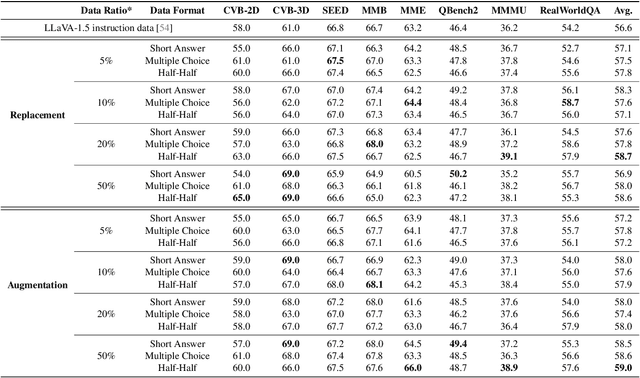
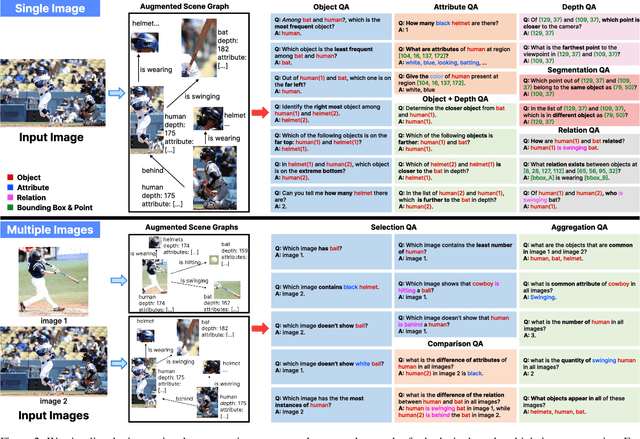
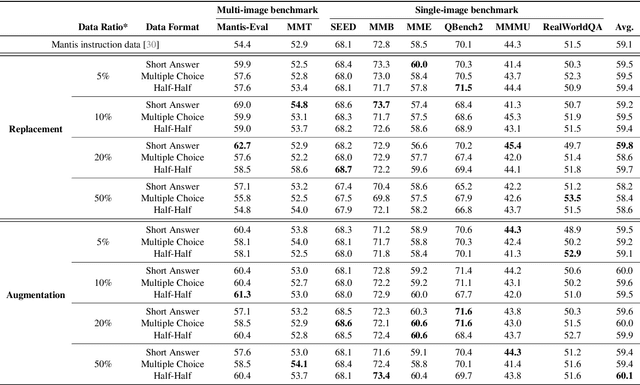
Abstract:With the rise of multimodal applications, instruction data has become critical for training multimodal language models capable of understanding complex image-based queries. Existing practices rely on powerful but costly large language models (LLMs) or multimodal language models (MLMs) to produce instruction data. These are often prone to hallucinations, licensing issues and the generation process is often hard to scale and interpret. In this work, we present a programmatic approach that employs scene graphs as symbolic representations of images and human-written programs to systematically synthesize vision-centric instruction data. Our approach ensures the interpretability and controllability of the data generation process and scales efficiently while maintaining factual accuracy. By implementing a suite of 24 single-image, 14 multi-image instruction generators, and a scene graph generation pipeline, we build a scalable, cost-effective system: ProVision which produces diverse question-answer pairs concerning objects, attributes, relations, depth, etc., for any given image. Applied to Visual Genome and DataComp datasets, we generate over 10 million instruction data points, ProVision-10M, and leverage them in both pretraining and instruction tuning stages of MLMs. When adopted in the instruction tuning stage, our single-image instruction data yields up to a 7% improvement on the 2D split and 8% on the 3D split of CVBench, along with a 3% increase in performance on QBench2, RealWorldQA, and MMMU. Our multi-image instruction data leads to an 8% improvement on Mantis-Eval. Incorporation of our data in both pre-training and fine-tuning stages of xGen-MM-4B leads to an averaged improvement of 1.6% across 11 benchmarks.
NaturalBench: Evaluating Vision-Language Models on Natural Adversarial Samples
Oct 18, 2024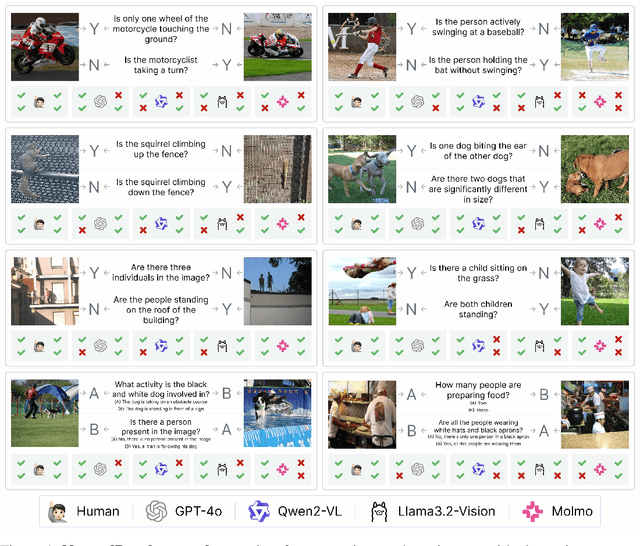
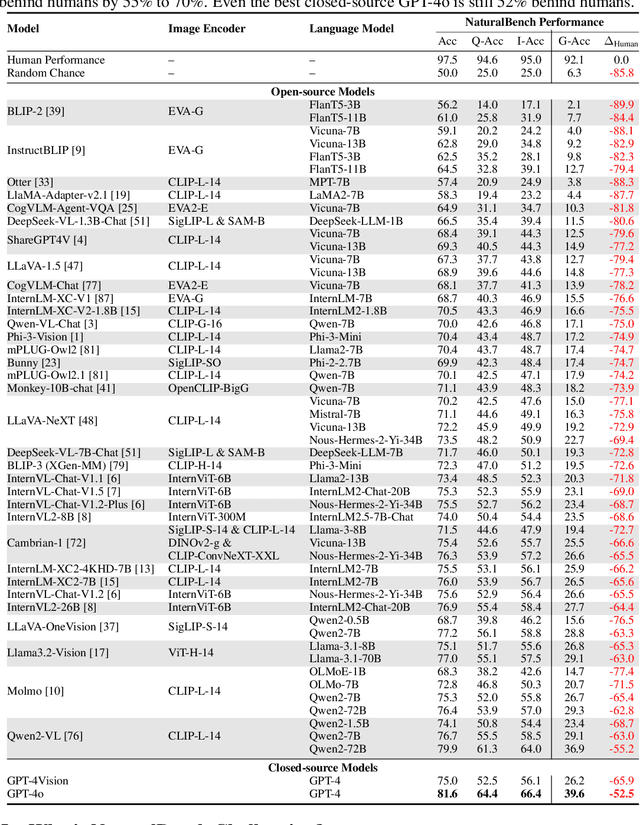
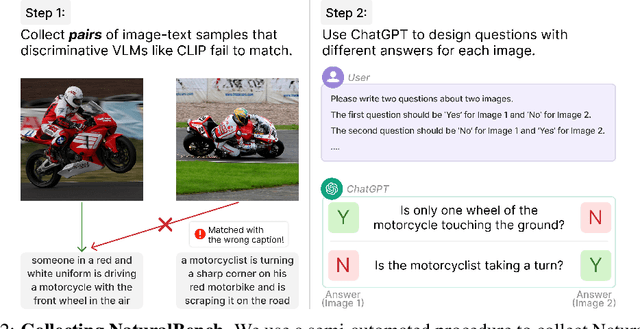

Abstract:Vision-language models (VLMs) have made significant progress in recent visual-question-answering (VQA) benchmarks that evaluate complex visio-linguistic reasoning. However, are these models truly effective? In this work, we show that VLMs still struggle with natural images and questions that humans can easily answer, which we term natural adversarial samples. We also find it surprisingly easy to generate these VQA samples from natural image-text corpora using off-the-shelf models like CLIP and ChatGPT. We propose a semi-automated approach to collect a new benchmark, NaturalBench, for reliably evaluating VLMs with 10,000 human-verified VQA samples. Crucially, we adopt a $\textbf{vision-centric}$ design by pairing each question with two images that yield different answers, preventing blind solutions from answering without using the images. This makes NaturalBench more challenging than previous benchmarks that can be solved with commonsense priors. We evaluate 53 state-of-the-art VLMs on NaturalBench, showing that models like LLaVA-OneVision, Cambrian-1, Llama3.2-Vision, Molmo, Qwen2-VL, and even GPT-4o lag 50%-70% behind human performance (over 90%). We analyze why NaturalBench is hard from two angles: (1) Compositionality: Solving NaturalBench requires diverse visio-linguistic skills, including understanding attribute bindings, object relationships, and advanced reasoning like logic and counting. To this end, unlike prior work that uses a single tag per sample, we tag each NaturalBench sample with 1 to 8 skill tags for fine-grained evaluation. (2) Biases: NaturalBench exposes severe biases in VLMs, as models often choose the same answer regardless of the image. Lastly, we apply our benchmark curation method to diverse data sources, including long captions (over 100 words) and non-English languages like Chinese and Hindi, highlighting its potential for dynamic evaluations of VLMs.
Task Me Anything
Jun 17, 2024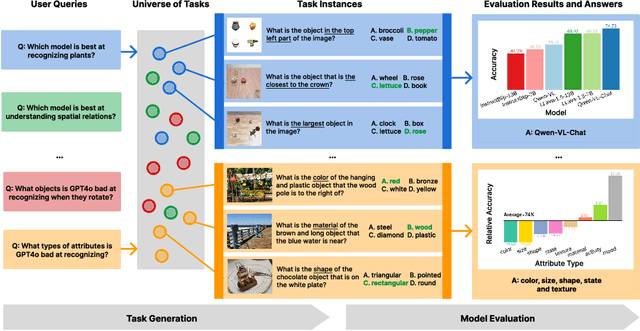

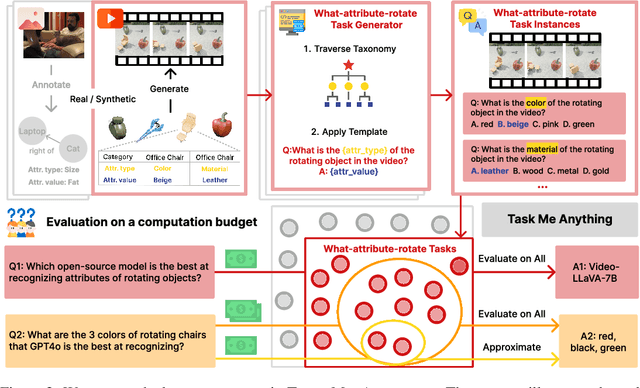

Abstract:Benchmarks for large multimodal language models (MLMs) now serve to simultaneously assess the general capabilities of models instead of evaluating for a specific capability. As a result, when a developer wants to identify which models to use for their application, they are overwhelmed by the number of benchmarks and remain uncertain about which benchmark's results are most reflective of their specific use case. This paper introduces Task-Me-Anything, a benchmark generation engine which produces a benchmark tailored to a user's needs. Task-Me-Anything maintains an extendable taxonomy of visual assets and can programmatically generate a vast number of task instances. Additionally, it algorithmically addresses user queries regarding MLM performance efficiently within a computational budget. It contains 113K images, 10K videos, 2K 3D object assets, over 365 object categories, 655 attributes, and 335 relationships. It can generate 750M image/video question-answering pairs, which focus on evaluating MLM perceptual capabilities. Task-Me-Anything reveals critical insights: open-source MLMs excel in object and attribute recognition but lack spatial and temporal understanding; each model exhibits unique strengths and weaknesses; larger models generally perform better, though exceptions exist; and GPT4o demonstrates challenges in recognizing rotating/moving objects and distinguishing colors.
m&m's: A Benchmark to Evaluate Tool-Use for multi-step multi-modal Tasks
Mar 21, 2024Abstract:Real-world multi-modal problems are rarely solved by a single machine learning model, and often require multi-step computational plans that involve stitching several models. Tool-augmented LLMs hold tremendous promise for automating the generation of such computational plans. However, the lack of standardized benchmarks for evaluating LLMs as planners for multi-step multi-modal tasks has prevented a systematic study of planner design decisions. Should LLMs generate a full plan in a single shot or step-by-step? Should they invoke tools directly with Python code or through structured data formats like JSON? Does feedback improve planning? To answer these questions and more, we introduce m&m's: a benchmark containing 4K+ multi-step multi-modal tasks involving 33 tools that include multi-modal models, (free) public APIs, and image processing modules. For each of these task queries, we provide automatically generated plans using this realistic toolset. We further provide a high-quality subset of 1,565 task plans that are human-verified and correctly executable. With m&m's, we evaluate 6 popular LLMs with 2 planning strategies (multi-step vs. step-by-step planning), 2 plan formats (JSON vs. code), and 3 types of feedback (parsing/verification/execution). Finally, we summarize takeaways from our extensive experiments. Our dataset and code are available on HuggingFace (https://huggingface.co/datasets/zixianma/mnms) and Github (https://github.com/RAIVNLab/mnms).
SugarCrepe: Fixing Hackable Benchmarks for Vision-Language Compositionality
Jun 26, 2023Abstract:In the last year alone, a surge of new benchmarks to measure compositional understanding of vision-language models have permeated the machine learning ecosystem. Given an image, these benchmarks probe a model's ability to identify its associated caption amongst a set of compositional distractors. Surprisingly, we find significant biases in all these benchmarks rendering them hackable. This hackability is so dire that blind models with no access to the image outperform state-of-the-art vision-language models. To remedy this rampant vulnerability, we introduce SugarCrepe, a new benchmark for vision-language compositionality evaluation. We employ large language models, instead of rule-based templates used in previous benchmarks, to generate fluent and sensical hard negatives, and utilize an adversarial refinement mechanism to maximally reduce biases. We re-evaluate state-of-the-art models and recently proposed compositionality inducing strategies, and find that their improvements were hugely overestimated, suggesting that more innovation is needed in this important direction. We release SugarCrepe and the code for evaluation at: https://github.com/RAIVNLab/sugar-crepe.
 Add to Chrome
Add to Chrome Add to Firefox
Add to Firefox Add to Edge
Add to Edge